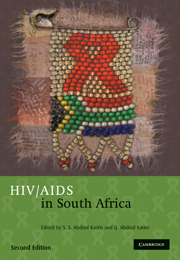Book contents
- Frontmatter
- Contents
- List of Contributors
- Foreword: Peter Piot
- Foreword: Nelson R Mandela
- Acknowledgements
- Section 1 Birth of a rapidly growing epidemic
- Section 2 The virus, the human host and their interactions
- Section 3 HIV risk factors and prevention strategiess
- Section 4 Focal groups for understanding the HIV epidemic
- Section 5 The impact of AIDS
- 21 Impact of AIDS – the health care burden
- 22 The impact of AIDS on the community
- 23 The impact on ethics
- 24 The economic impact of AIDS
- 25 AIDS-related mortality in South Africa
- 26 Picking up the pieces: the end of AIDS denialism and its aftermath
- Section 6 Treating HIV
- Section 7 What does the future hold?
- Index
25 - AIDS-related mortality in South Africa
Published online by Cambridge University Press: 07 September 2011
- Frontmatter
- Contents
- List of Contributors
- Foreword: Peter Piot
- Foreword: Nelson R Mandela
- Acknowledgements
- Section 1 Birth of a rapidly growing epidemic
- Section 2 The virus, the human host and their interactions
- Section 3 HIV risk factors and prevention strategiess
- Section 4 Focal groups for understanding the HIV epidemic
- Section 5 The impact of AIDS
- 21 Impact of AIDS – the health care burden
- 22 The impact of AIDS on the community
- 23 The impact on ethics
- 24 The economic impact of AIDS
- 25 AIDS-related mortality in South Africa
- 26 Picking up the pieces: the end of AIDS denialism and its aftermath
- Section 6 Treating HIV
- Section 7 What does the future hold?
- Index
Summary
INFORMATION ON VITAL STATISTICS and mortality is important for planning resource allocation, identifying vulnerable households and communities and for town and regional planning. The rapid increase in young adult mortality in the late 1990s in South Africa, as estimated by the Medical Research Council's report on adult mortality, provides compelling evidence of the impact of the maturing HIV/AIDS epidemic, particularly among young women. This observation has been borne out from comparisons with data collected in two rural districts in South Africa. While there are anecdotal accounts of similar impacts in child mortality, the limited number of birth registrations makes the population register an unreliable tool for assessing trends in child mortality.
Models calibrated to available data have played an important role in estimating the cause of death profile. Estimates of the burden of disease show that by the year 2000, hiv/aids was already the biggest single cause of death. The Department of Health is in the process of rolling out a comprehensive treatment and care programme including antiretrovirals. Without better mortality data, and more timely production of statistics, it will be difficult, if not impossible, to monitor reliably the impact of these programmes. Urgent efforts are needed to improve the quality and timely production of statistics to monitor the effectiveness of these expensive and important programmes.
- Type
- Chapter
- Information
- HIV/AIDS in South Africa , pp. 432 - 443Publisher: Cambridge University PressPrint publication year: 2010
- 1
- Cited by



